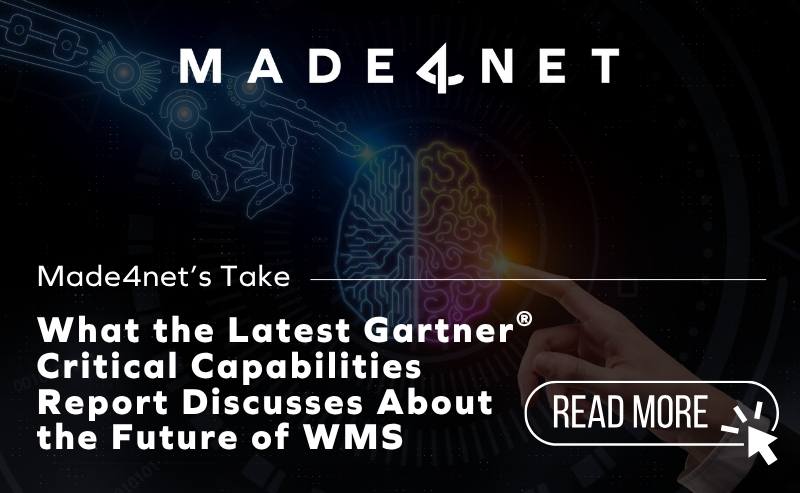
The Warehouse Management System (WMS) market may be mature—but it’s far from standing still. According to the latest 2025 Gartner Critical Capabilities for Warehouse Management Systems report, innovation in the WMS space is accelerating at a rapid pace.
As warehouses evolve to meet rising customer expectations, adopt new fulfillment models, and embrace automation, buyers are looking for more than just robust core functionality. Today’s leading organizations need WMS platforms that are flexible, intuitive, and built for continuous transformation.
What’s driving this shift? In our opinion, cutting-edge capabilities are quickly becoming market differentiators, including:
- Robotics and multiagent orchestration (MAO)
- Generative AI for chatbots and query engines
- Advanced analytics for smarter decisions
- Gamification and employee engagement tools to enhance workforce performance
These advancements aren’t just “nice to have” anymore—they’re rapidly becoming the standard for staying competitive in modern, high-performance supply chains.
A New Lens on Capability
This year, Gartner evaluated WMS solutions across five Warehouse Operation Use Cases—ranging from low to high complexity—and assessed each vendor across 11 critical capabilities, including:
- Core and extended functionality
- Usability
- Implementation and integration tools
- Analytics and performance management
- Systems/technical architecture (new)
- Intralogistics smart robotics support (new)
- Materials handling integration
- Simplicity of use and operation
- Adaptability
- Supporting technologies
According to Amit Levy, Executive Vice President of Sales & Strategy at Made4net, “In our opinion, these updates reflect the reality that WMS decisions are no longer just about picking the platform with the most features. Instead, buyers are focused on finding the right-fit solution that aligns with their unique warehouse environment—whether that’s a Level 2 site with basic functionality or a Level 5 facility heavily automated and orchestrating human, material handling equipment and robotics systems.”
Key Trends Shaping the WMS Landscape
Levy highlights a few standout themes from this year’s report that he believes should shape how organizations evaluate WMS platforms in 2025 and beyond. In his opinion:
Architecture Is Now a Dealbreaker
Gartner predicts that “through 2027, systems/technical architecture will equal functionality in importance for new WMS buyers seeking flexibility, adaptability, composability, usability, and affordability.” Buyers are looking for composable, upgrade-friendly, and cloud-native platforms that won’t trap them in rigid upgrade cycles or require heavy customization to keep pace.
User Experience Takes Center Stage
“By 2028, over 70% of WMS buyers will consider user experience as one of the top criteria in evaluations”. From intuitive UIs to visual warehouse mapping, intuitive design is now a business requirement, not just a UX luxury.
Automation and Computer Vision-AI Are Reshaping the Warehouse
“By 2028, 80% of warehouses and distribution centers will deploy some form of robotics and/or automation”—in our opinion, this makes it clear that automation is no longer optional, but essential. And it’s not just about machines on the move. Emerging technologies like Computer Vision-AI are poised to disrupt traditional inventory tracking, with the potential to replace RFID as the standard for asset and inventory visibility.
To keep up, WMS platforms must support more than just basic automation. We feel that the Gartner report discusses the growing need for warehouse execution systems (WES), plug-in connectors for material flow equipment, and embedded orchestration capabilities that can coordinate humans, robots, and systems in real time.
AI Is Moving from Hype to Reality
WMS platforms are beginning to integrate agentic and generative AI, supporting everything from chatbots to intelligent exception handling and adaptive workflows. Gartner suggests these capabilities will play an increasing role in decision-making.
Unified Orchestration Is the New Must-Have
As warehouses increasingly rely on a mix of manual labor and automation, resource orchestration has become critical. WMS vendors are prioritizing unified control layers that can seamlessly coordinate robots, human workers, and material handling systems—enabling real-time adaptability and smoother operations in complex, hybrid environments.
What This Means for Buyers
The key takeaway from this year’s Critical Capabilities report? Made4net believes its longer about chasing the most feature-rich solution—it’s about choosing the platform that best aligns with your operational complexity, growth trajectory, and innovation goals.
We encourage WMS buyers to consider:
- Can this system scale with my operations—from my current state to support future growth and expansion plans?
- Does it support automation and robotics integration now, not just on a roadmap?
- Will my users actually enjoy using this platform—or will it require constant workarounds and retraining?
- How easily can I configure it to fit my processes without the involvement of the vendor and my IT?
Made4net: A Proven Performer Across All Levels of Complexity
In our view, while many WMS vendors shine in select areas, Made4net stands out for its balanced strength across the board. It offers a flexible, adaptable solution that consistently performs well across a range of warehouse complexity levels. In fact, Made4net is the only solution to score 3.0 or higher in all five Warehouse Operation Use Cases—we believe, a clear indicator of both versatility and reliability.
In our opinion, our placement in the Level 2 and Level 3 use cases make Made4net a smart choice for fast-scaling operations that need intuitive tools today and advanced capabilities for tomorrow.
SCExpert, Made4net’s unified supply chain platform, combines WMS, TMS, yard, labor, and delivery management on a single technical foundation—offering deep integration and eliminating the headache of juggling multiple vendors.
Levy highlights a few of the platform’s standout capabilities:
User-Friendly & Adaptable
- Modern & intuitive UI and visual warehouse viewer
- No-code configuration tools (screen generators, workflow designers)
- Extensive labeling, documentation, and integration tools
Built-In Support for Automation
- Compatible with pick-by-vision, voice, RFID, and robotics
- Embedded WCS capabilities (also available as a standalone)
- Connector driven integration for material handling equipment
And explains, “Not all WMS platforms are built for where your warehouse is now—and even fewer are built for where it’s going. Made4net hits the sweet spot between ease-of-use, configurability, and scalable performance.”
Choosing the Right WMS
If you’re evaluating WMS options in 2025, don’t just follow the feature checklist—look for the platform that can adapt, grow, and deliver real-world results at every step of your journey. We encourage you to use Gartner WMS research as part of your evaluation of WMS products. For the latest 2025 Gartner Magic Quadrant® for WMS report, click here. To meet with one of our experts and discuss how the key takeaways from this article may impact your unique operation, get in touch.
Disclaimer:
Gartner, Critical Capabilities for Warehouse Management Systems, : Rishabh Narang, Simon Tunstall, Dwight Klappich, Federica Stufano, 28 May 2025
GARTNER is a registered trademark and service mark of Gartner, Inc. and/or its affiliates in the U.S. and internationally, and MAGIC QUADRANT is a registered trademark of Gartner, Inc. and/or its affiliates and are used herein with permission. All rights reserved.
Gartner does not endorse any vendor, product or service depicted in its research publications and does not advise technology users to select only those vendors with the highest ratings or other designation. Gartner research publications consist of the opinions of Gartner’s research organization and should not be construed as statements of fact. Gartner disclaims all warranties, expressed or implied, with respect to this research, including any warranties of merchantability or fitness for a particular purpose.


